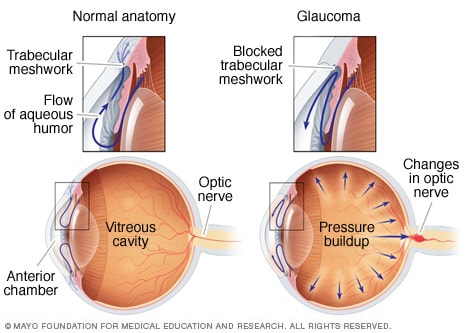Glaucoma Symptoms
Symptoms
The symptoms of glaucoma depend on the type and stage of your condition.
Open-angle glaucoma:
- No symptoms in early stages
- Gradually, patchy blind spots in your side vision. Side vision also is known as peripheral vision
- In later stages, difficulty seeing things in your central vision

Acute angle-closure glaucoma:
- Severe headache
- Severe eye pain
- Nausea or vomiting
- Blurred vision
- Halos or colored rings around lights
- Eye redness
Normal-tension glaucoma:
- No symptoms in early stages
- Gradually, blurred vision
- In later stages, loss of side vision
Glaucoma in children:
- A dull or cloudy eye (infants)
- Increased blinking (infants)
- Tears without crying (infants)
- Blurred vision
- Nearsightedness that gets worse
- Headache
Pigmentary glaucoma:
- Halos around lights
- Blurred vision with exercise
- Gradual loss of side vision
When to see a doctor:
If you experience symptoms that come on suddenly, you may have acute angle-closure glaucoma. Symptoms include severe headache and severe eye pain. You need treatment as soon as possible. Go to an emergency room or call an eye doctor's (ophthalmologist's) office immediately.
Causes
Glaucoma develops when the optic nerve becomes damaged. As this nerve gradually deteriorates, blind spots develop in your vision. For reasons that doctors don't fully understand, this nerve damage is usually related to increased pressure in the eye.
Elevated eye pressure happens as the result of a buildup of fluid that flows throughout the inside of the eye. This fluid also is known as the aqueous humor. It usually drains through a tissue located at the angle where the iris and cornea meet. This tissue also is called the trabecular meshwork. The cornea is important to vision because it lets light into the eye. When the eye makes too much fluid or the drainage system doesn't work properly, eye pressure may increase.
Open-angle glaucoma:
This is the most common form of glaucoma. The drainage angle formed by the iris and cornea remains open. But other parts of the drainage system don't drain properly. This may lead to a slow, gradual increase in eye pressure.
Angle-closure glaucoma:
This form of glaucoma occurs when the iris bulges. The bulging iris partially or completely blocks the drainage angle. As a result, fluid can't circulate through the eye and pressure increases. Angle-closure glaucoma may occur suddenly or gradually.
Normal-tension glaucoma:
No one knows the exact reason why the optic nerve becomes damaged when eye pressure is normal. The optic nerve may be sensitive or experience less blood flow. This limited blood flow may be caused by the buildup of fatty deposits in the arteries or other conditions that damage circulation. The buildup of fatty deposits in the arteries also is known as atherosclerosis.
Glaucoma in children:
A child may be born with glaucoma or develop it in the first few years of life. Blocked drainage, injury or an underlying medical condition may cause optic nerve damage.
Pigmentary glaucoma:
In pigmentary glaucoma, small pigment granules flake off from the iris and block or slow fluid drainage from the eye. Activities such as jogging sometimes stir up the pigment granules. That leads to a deposit of pigment granules on tissue located at the angle where the iris and cornea meet. The granule deposits cause an increase in pressure.
Glaucoma tends to run in families. In some people, scientists have identified genes related to high eye pressure and optic nerve damage.
Risk factors
Glaucoma can damage vision before you notice any symptoms. So be aware of these risk factors:
- High internal eye pressure, also known as intraocular pressure
- Age over 55
- Black, Asian or Hispanic heritage
- Family history of glaucoma
- Certain medical conditions, such as diabetes, migraines, high blood pressure and sickle cell anemia
- Corneas that are thin in the center
- Extreme nearsightedness or farsightedness
- Eye injury or certain types of eye surgery
- Taking corticosteroid medicines, especially eye drops, for a long time
Some people have narrow drainage angles, putting them at increased risk of angle-closure glaucoma.
Prevention
These steps may help detect and manage glaucoma in its early stages. That may help to prevent vision loss or slow its progress.
- Get regular eye examinations. Regular comprehensive eye exams can help detect glaucoma in its early stages, before significant damage occurs. As a general rule, the American Academy of Ophthalmology recommends a comprehensive eye exam every 5 to 10 years if you're under 40 years old; every 2 to 4 years if you're 40 to 54 years old; every 1 to 3 years if you're 55 to 64 years old; and every 1 to 2 years if you're older than 65. If you're at risk of glaucoma, you'll need more frequent screening. Ask your health care provider to recommend the right screening schedule for you.
- Know your family's eye health history. Glaucoma tends to run in families. If you're at increased risk, you may need more frequent screening.
- Wear eye protection. Serious eye injuries can lead to glaucoma. Wear eye protection when using power tools or playing sports.
- Take prescribed eye drops regularly. Glaucoma eye drops can significantly reduce the risk that high eye pressure will progress to glaucoma. Use eye drops as prescribed by your health care provider even if you have no symptoms.
